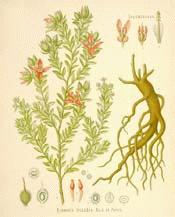
Botanical.com Home Page

|
Rhatany
(Krameria lappacea printed as
Krameria triandra Ruiz et Pavon)
Click on graphic for larger image
|
Rhatany
Botanical: Krameria triandra (R. and P.)
Family: N.O. Polygalaceae
---Synonyms---Rhatanhia. Ratanhiawurzel. Krameria Root. Peruvian Rhatany. Mapato. Pumacuchu. Raiz para los dientes. Red Rhatany.
---Part Used---Dried root.
---Habitat---Peru.
---Description---A low shrub with large red flowers, growing on dry, sandy places on mountain-slopes, 3,000 to 8,000 feet above sea-level in several provinces of Peru, especially near the city of Huanuco. The root, as found in commerce, consists of long, cylindrical pieces, varying in thickness from 1/4 to 1/2 inch or more (long Rhatany), or a short, thick portion, knotted, and as large as a man's fist (short, or stumpy Rhatany). The difference is caused by the diggers, the former being removed by them with care, and the latter torn up with force. The bark of the root is thin, readily separable, rough and scaly; of a dark, reddish-brown colour outside, and bright brownish-red within. It breaks with a somewhat fibrous fracture, is tough and difficult to powder, and has a strong, purely astringent taste, tingeing the saliva red when chewed. The central woody portion is very hard and almost tasteless. Neither bark nor wood has any marked odour. As the virtues of Rhatany reside in the bark, the smaller pieces are preferable.
A strong tincture of these roots in brandy is used in Portugal to impart roughness to port wines.
The genus Krameria was named after Kramer, a Hungarian physician and botanist. The name Rhatany is said to describe the creeping character of the plant, in the language used by the Peruvian Indians, while its Spanish name is derived from its dental properties.
The dried roots of two species besides the Peruvian are official: Krameria Ixené, or Savanilla Rhatany, and Krameria Argentea, known in commerce as Para or Brazilian Rhatany.
Krameria was dropped from the United States Pharmacopceia but retained in the British Pharmacopceia and National Formulary.
[Top]
---Constituents---The essential constituent is a peculiar tannic acid, known as Rhataniatannic acid or Krameria tannic acid, closely allied to catechu-tannic acid. By the action of dilute acid it is decomposed into a crystallizable sugar, and Rhatania-red. No gallic acid is present. Rhatanin is a homologue of tyrosine, and is identical with angelin, geoffrayin, and andirin. It appears to contain also lignin, and small quantities of gum starch, saccharine matter, and a peculiar acid, krameric acid. The mineral acids and most of the metallic salts throw down precipitates with the infusion, decoction and tincture of Rhatany, and are incompatible in prescription.
Cold water extracts all the astringency of Rhatany.
Very inferior extracts of Rhatany are often sold. Its virtues may be considered as in proportion to its solubility.
---Medicinal Action and Uses---An active as tringent, and slightly tonic. It has beenfound useful for internal administration in chronic diarrhoea, dysentery, menorrhagia, incontinence of urine, haematuria, and passive haemorrhage from the bowels. In the form of an infusion it has been used locally in fissure of the anus, prolapsus ani, and leucorrhoea; as a gargle in relaxed, sore throat; and as an astringent wash for the mucous membrane of the eyes, nose, gums, etc.
The powder is also used as a dentifrice when mixed with equal parts of orris rhizome and charcoal, or with prepared chalk and myrrh.
---Preparations and Dosages---Tincture of 20 per cent krameria and diluted alcohol, 1 fluid drachm. Syrup of 45 per cent fluid extract of krameria and syrup - as an intestinal astringent - 1 fluid drachm. Of the powder (rarely used), 20 to 30 grains. Lozenges are also prepared, with cocaine. Powdered root, 10 to 30 grains. Fluid extract, 10 to 60 drops. Tincture, B.P., and U.S.P., 1/2 to 1 drachm. Infusion, B.P., 1/2 to 1 OZ. Solid extract, U.S.P., 5 to 8 grains. Solid extract, B.P., 5 to 15 grains. Concentrated solution, B.P., 1/2 to 1 drachm.
---Other Species---
A Rhatany from Guayaquil appeared on the London market, yielding a larger quantity of tannin than the Peruvian drug, but less than the other two species. A spurious Rhatany from Peru, of unknown botanical origin, has also been put on the market. The Krameria lanceolate (Texan Rhatany) of North America, is richer in tannin than the official drug. It takes a deep purple colour when treated with iron, while Para gives a dirty brown and Savanilla violet.
The powder is of a reddish-brown colour.
[Top]
Common Name Index
A MODERN HERBAL Home Page
Bear in mind "A Modern Herbal" was written with the conventional wisdom of the early 1900's. This should be taken into account as some of the information may now be considered inaccurate, or not in accordance with modern medicine.
© Copyright Protected 1995-2025 Botanical.com
|

